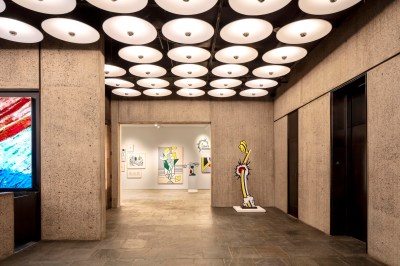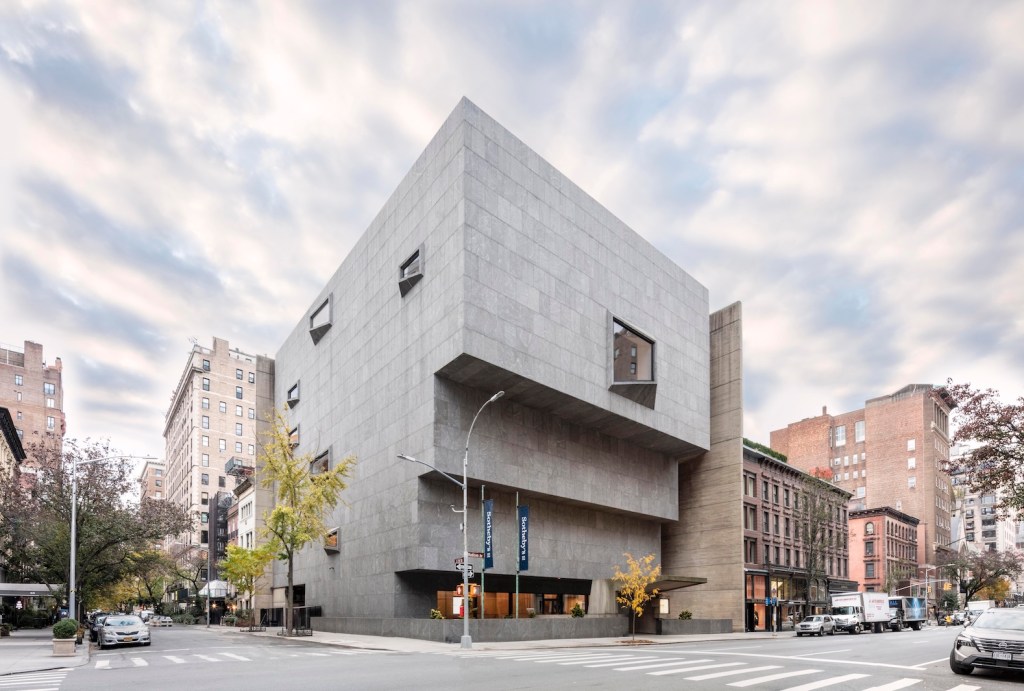Sotheby’s did not just open a new headquarters this week—it staged a return to form.
The auction house has taken over Marcel Breuer’s Brutalist landmark on Madison Avenue, a building that has already lived several cultural lives: it was the longtime home of the Whitney Museum, then the Met Breuer, followed by a short-lived contemporary art annex of the Metropolitan Museum of Art and a temporary Frick Collection outpost. Now, after a renovation by Herzog & de Meuron, Breuer’s building becomes something else again—not a museum, exactly, but a museum-sized showroom.
The building’s architectural bones remain unmistakable. The cantilevered granite façade, the deep-set windows, the weight of postwar seriousness. What’s new is what happens inside. Herzog & de Meuron’s self-described “quasi-invisible” intervention was a matter of subtraction more than addition: removing office partitions, restoring original gallery proportions, and installing the kind of climate, sound, and lighting systems expected of an auction house that can sell a painting for the price of a Manhattan skyscraper.
Visitors entering the lobby are immediately pulled between spectacle and restraint. On one wall hangs a monumental Damien Hirst cherry-blossom painting, while opposite it is a hard-edged, rainbow-hued concentric square work by Frank Stella. To the left stands a hefty Jean Arp sculpture. Vitrines display jewelry from Cartier and David Webb, Rolexes, Patek Phillippes, and of course a limited edition Birkin Bag, under surgical lighting; to the right, rare manuscripts including a first editions of The Hobbit and Alice in Wonderland — a visual split-screen of glamour and scholarship. The ceilings are still lined with Breuer’s saucer-like fixtures. The terrazzo flooring, studiously grey, and the classic stone walls are intact, giving the lobby an elegant, sturdy feel that just on the secular side of ecclesiastic. But the building has shifted from contemplation to transaction, or, as Sotheby’s might argue, from passive viewing to active circulation.

Sotheby’s Breuer lobby gallery, featuring works from the Collection of Dorothy and Roy Lichtenstein.
Photography by Stefan Ruiz. Courtesy of Sotheby’s
Sotheby’s is inaugurating the space not with a single sale, but with a sequence of exhibitions that behave like a full-scale biennial of private wealth. Three truly exceptional single-owner collections — Leonard A. Lauder, Cindy and Jay Pritzker, and Exquisite Corpus — anchor the November season, together estimated at over a billion dollars on the high end, double last year’s total for the same season.
From the Lauder trove come three Gustav Klimts, each appearing at auction for the first time; from the Pritzker collection, a Van Gogh still life the house is billing as one of the artist’s finest examples still in private hands; and from Exquisite Corpus, a Frida Kahlo painting positioned to reset the record for a woman artist at auction. The contemporary evening sale centers on Basquiat’s Crowns (Peso Neto) and Maurizio Cattelan’s fully functional 18-karat gold toilet, America — a work whose opening bid will be pegged to the price of gold at the moment the gavel drops.
All of it is free for the public to view until the hammer falls.
With this move, Sotheby’s essentially turns an art-historical landmark into a commercial one. Unlike the old York Avenue HQ — a place you visited because you already had business there — the Breuer building will cater to walk-ins, tourists, collectors, influencers, and the merely curious. It’s a bet that the aura of museum-quality viewing can be merged with the velocity of high-end sales.
While the building is smaller that York Ave, it’s purpose is more singular and feels that way. Movable walls will allow the fourth gallery to transform into the sales floor on auction days albeit with a bit less room. York Ave. had room for just over 300 in person visitors for a sale. The Breuer has room for 200. To make up for that, the house has upped its live streaming game so that people viewing from home will “feel like that are in the room,” according to Lisa Dennison, Sotheby’s executive vice president and chairman, America’s. (Lisa, who for years worked at the Guggenheim gave the press a lovely a tour of the galleries and sales highlights, which started off with her pointing out that “I guess you can take the museum out of the girl but you can’t take the girl out of the museum.”)
Before the tours started, CEO Charles Stewart called the upcoming November sales the “biggest and best we’ve had in recent memory.” The subtext: Sotheby’s has spent the last five years building a global real-estate portfolio meant to match the geography of wealth; Hong Kong, Paris, now New York again — but with Madison Avenue prestige.
Whether this is a profound shift or a glamorously staged real-estate maneuver depends on how you define “public.” The art is free to see, but only until it is bought. The Breuer has always held art temporarily; this just shortens the timeline. But it’s a wonderfully chic (re)addition to Madison Ave and the New York art world as a whole.



